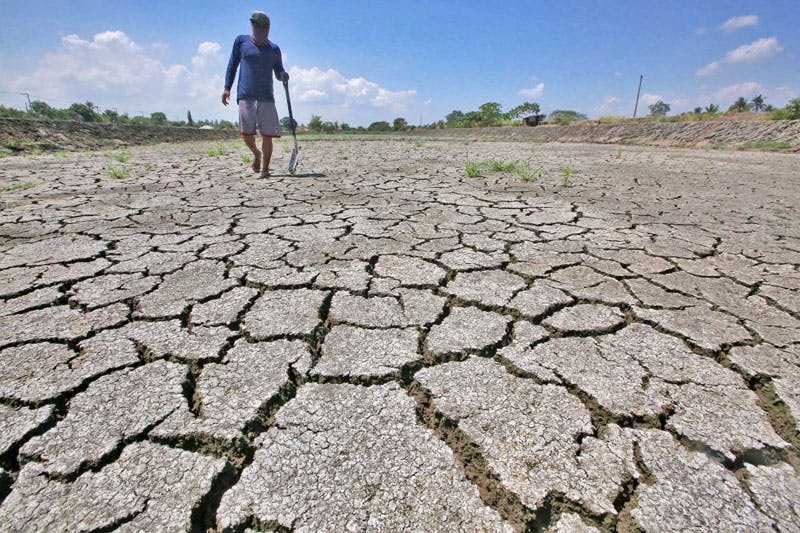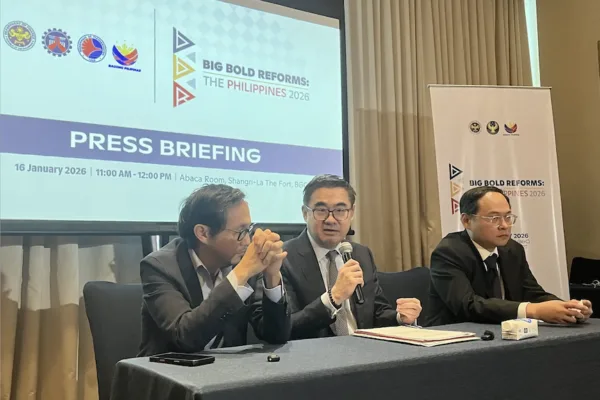Finance Secretary Ralph G. Recto has assured the Filipino public that the government is intensifying targeted actions to further protect the purchasing power of Filipinos from the effects of El Niño, and eventually, La Niña, on food and energy supplies.

A resident walks on a dried-up fish pond in Candaba town, Pampanga (IMAGE CREDIT: OneNews.PH)
In a press statement, the Finance Chief said the government is doing its best to address the ongoing El Niño situation while actively preparing for the anticipated La Niña phenomenon in the latter part of the year. One of these actions includes providing affected farmers and fisherfolks with financial assistance.
According to Recto, at least PHP 362.56 million worth of financial assistance has already been released through the Rice Farmers Financial Assistance (RFFA). In addition, the Agricultural Credit Policy Council (ACPC) has also allotted PHP 500 million under the Survival and Recovery (SURE) Loan Program to assist 20,000 borrowers, including farmers and fisherfolk, who will be affected by calamities in 2024.
“Rest assured, we are doubling down on our efforts to address the ongoing El Niño situation,” Recto said. “The inter-agency committee on inflation and market outlook is all hands on deck in monitoring weather-related disturbances as well as other external factors and their effects on the prices of essential goods to protect the Filipinos’ purchasing power.”
“Mitigating the effects of inflation, especially on our vulnerable sectors, is our top priority,” he added.
The effects of El Niño and La Niña
El Niño is characterized by abnormally dry and hot weather that brings drought or dry season, while La Niña is associated with above-normal rainfall that results in flooding.
These abnormal weather patterns, exacerbated by climate change, can adversely impact agricultural production and society. Droughts during El Niño reduce crop yields and increase the cost of electricity while excessive rainfall brought about by La Niña can lead to the overflowing of dams and flooding that damage crops and infrastructure.
The Philippine Atmospheric, Geophysical, and Astronomical Services Administration (PAGASA) reported that the El Niño weather started in January and is expected to settle between April and June. Meanwhile, there is a 55% probability of La Niña emerging by June to August 2024.
Despite the ongoing onslaught of El Niño in March, the government has managed to keep the inflation rate to 3.7%, which is within the target band of 2% to 4%. This is due to the vigorous implementation of measures that ensured sufficient imports of key commodities and improved agricultural production.
The slight uptick in March was largely due to a much higher inflation rate in rice (24.4% in March from 23.7% in February) since El Niño affected rice-producing countries in Southeast Asia and export limits in India drove international rice prices higher.
Financial aid for affected farmers
In a related development, the Presidential Communications Office (PCO) has released a statement saying that the Department of Agriculture has just been ordered to closely coordinate with the Philippine Crop Insurance Corp. (PCIC) to assess any regulation barriers imposed by the insurance commission to ensure that financial aid reaches the affected farmers promptly.
The PCO added that it has been tasked “to engage in collaborative efforts to devise engineering solutions that alleviate the need for extreme water conservation measures.”
According to data from the Department of Agriculture, the damage of the El Niño phenomenon to the agriculture sector in 10 regions has already reached P2.63 billion as of April 3 this year. It has also since affected 54,2023 farmers in the countryside.
The same data stated that among the regions affected are the Cordillera Administrative Region (CAR), Ilocos Region, Cagayan Valley, Central Luzon, Calabarzon, Mimaropa, Bicol Region, Western Visayas, the Zamboanga Peninsula, and Soccsksargen.
“The bulk of the damage was in rice with P1.7 billion, followed by corn at P591 million. In terms of areas, severely hit was Mimaropa region or Region 4-B at P770 million, followed closely by Western Visayas at P739 million damage,” said Arnel De Mesa, spokesman for the Department of Agriculture.
He added that despite the increase in the impact of El Niño on rice plantations, out of the 34,264 hectares affected, only 9,300 hectares were totally damaged while the remaining 25,000 hectares of damaged rice fields could still recover.







